Abstract
1 In chloralose-anaesthetized dogs pretreated with guanethidine and pancuronium, electrical stimulation (0.2 to 5 Hz) of the peripheral end of the cut tibial nerve caused a frequency-dependent increase in femoral blood flow which was restricted to the paw pads. 2 This neurogenic vasodilatation was not attenuated by atropine, mepyramine plus burimamide, indomethacin or propranolol. It was, however, attenuated in a dose-dependent manner by intra-arterial administration of the dopamine receptor antagonist, ergometrine (0.05 to 0.5 mg). 3 The effect of ergometrine could not be explained by non-specific effects on axonal conduction or transmission or by vasospasm of the blood vessels of the paw-pads. 4 In dogs with intact tibial nerves, a pharmacologically similar dilator response localized to the paw-pads could be elicited by electrical stimulation of loci in the ipsilateral diencephalon and midbrain. This response was not due to inhibition of adrenergic vasomotor tone and was abolished by systemic ganglion blockade or by tibial nerve section as well as by femoral arterial administration of ergometrine. 5 It is suggested that the vasculature of the canine paw pads is innervated by a population of autonomic axons which utilize dopamine or a related substance as a transmitter substance and activation of which causes vasodilation.
Full text
PDF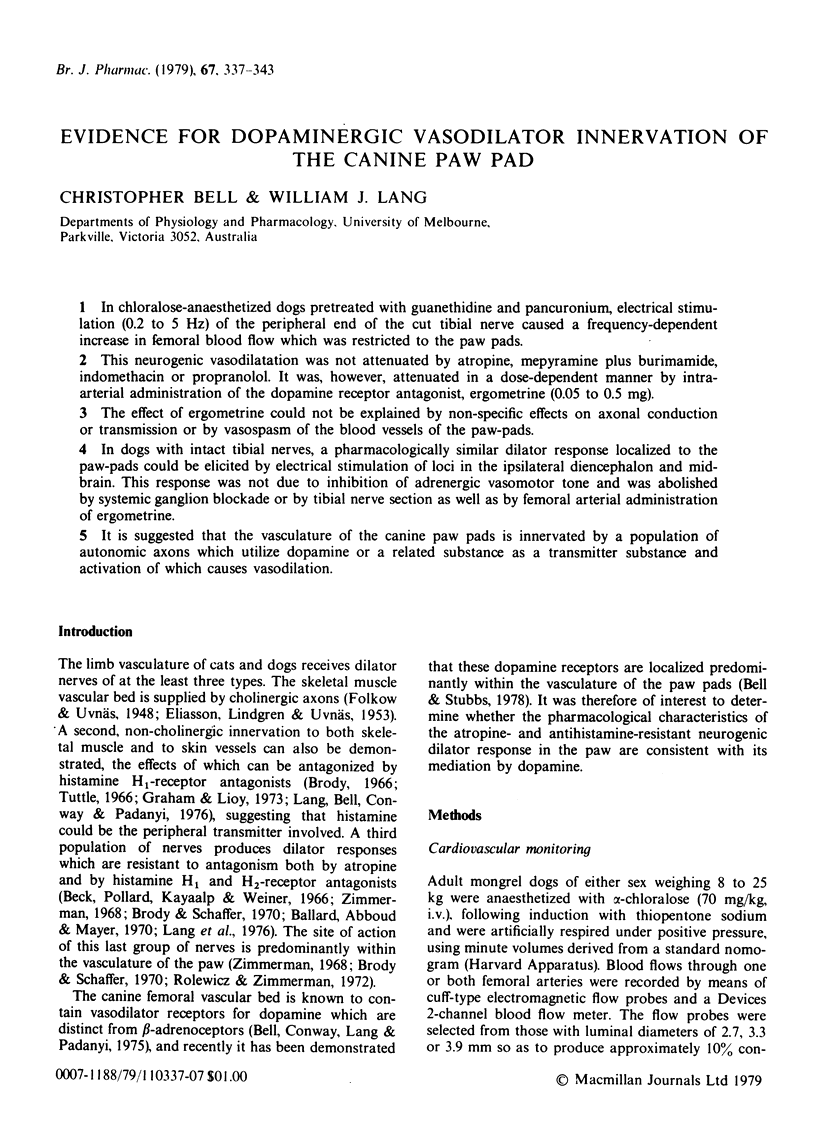
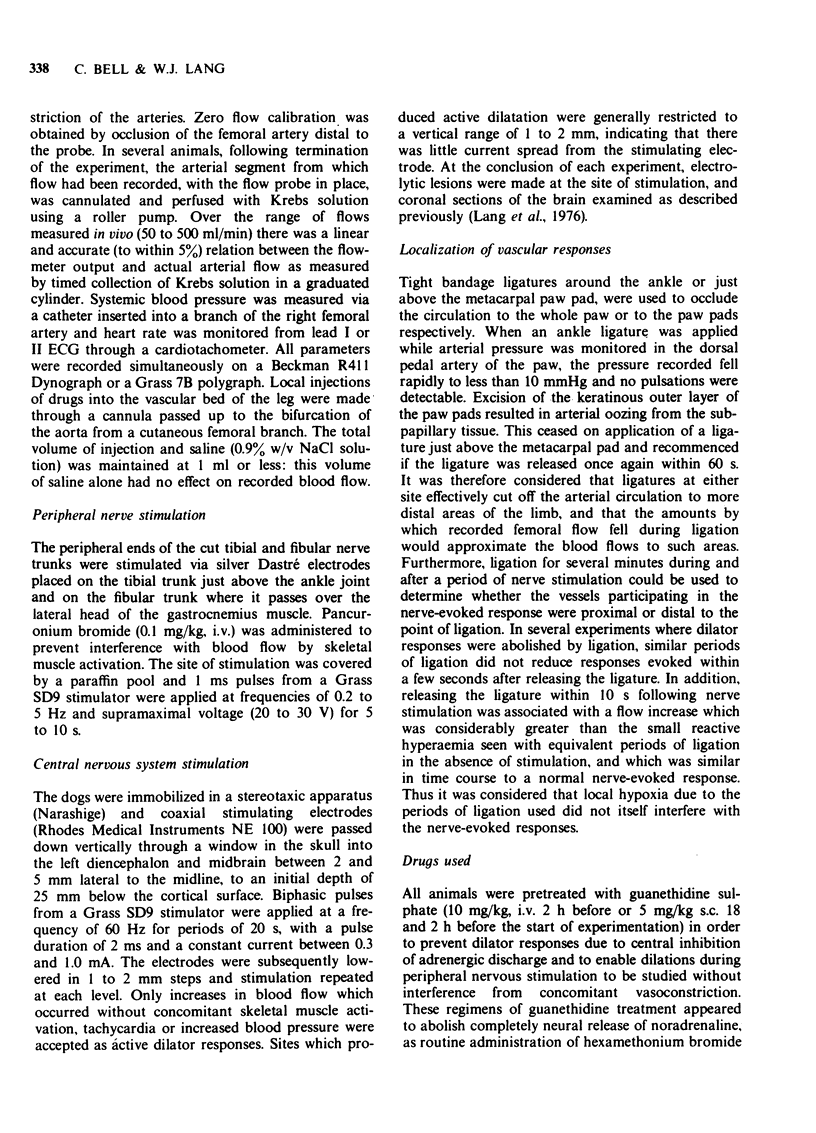
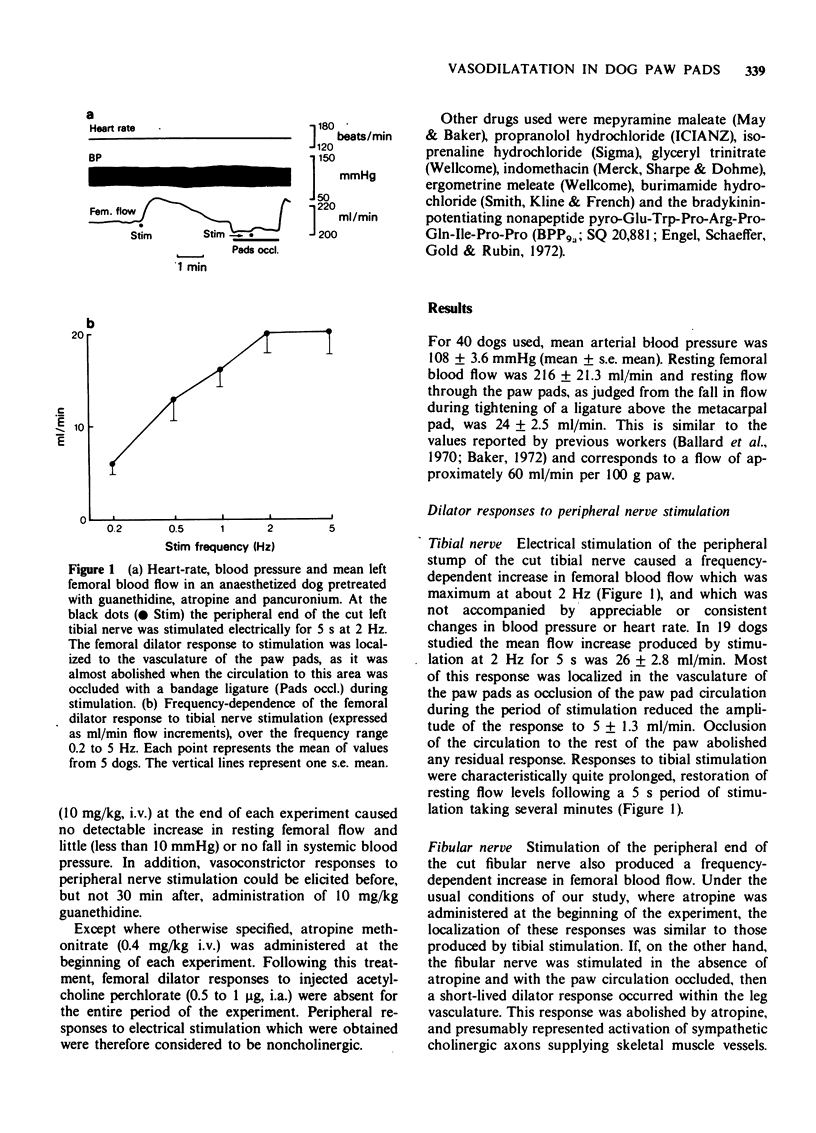
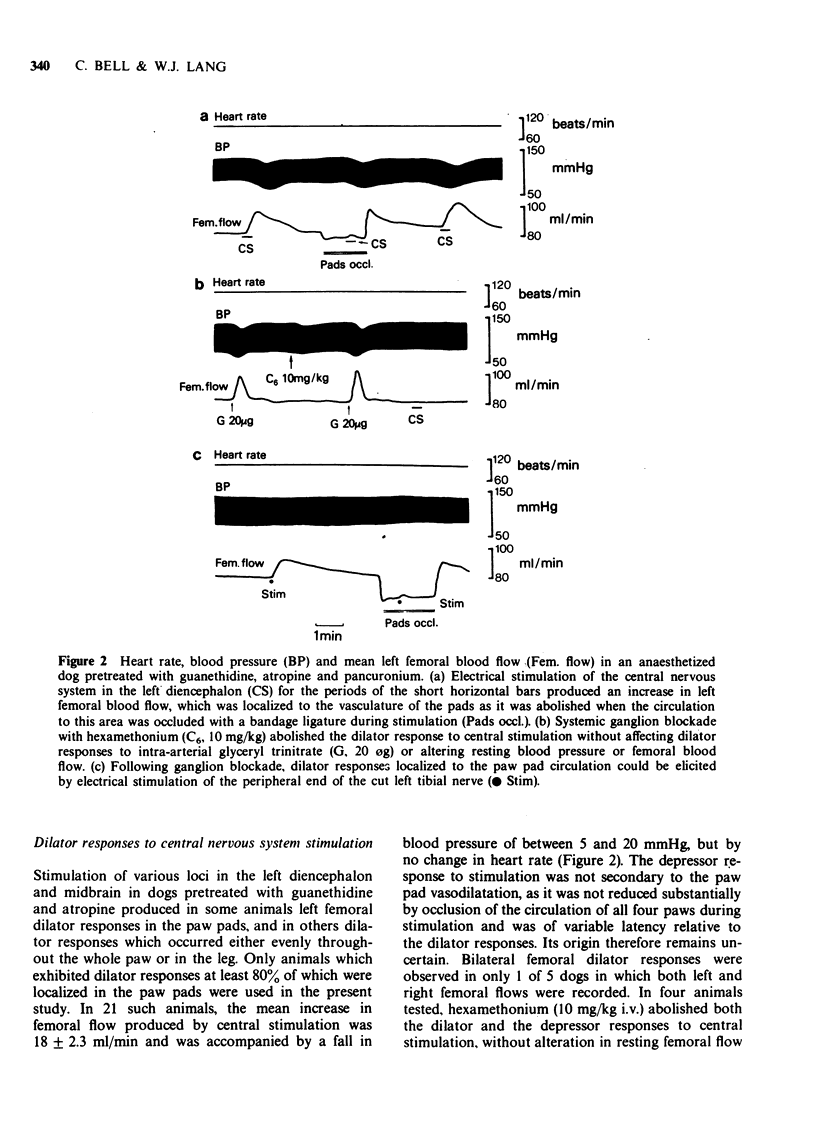
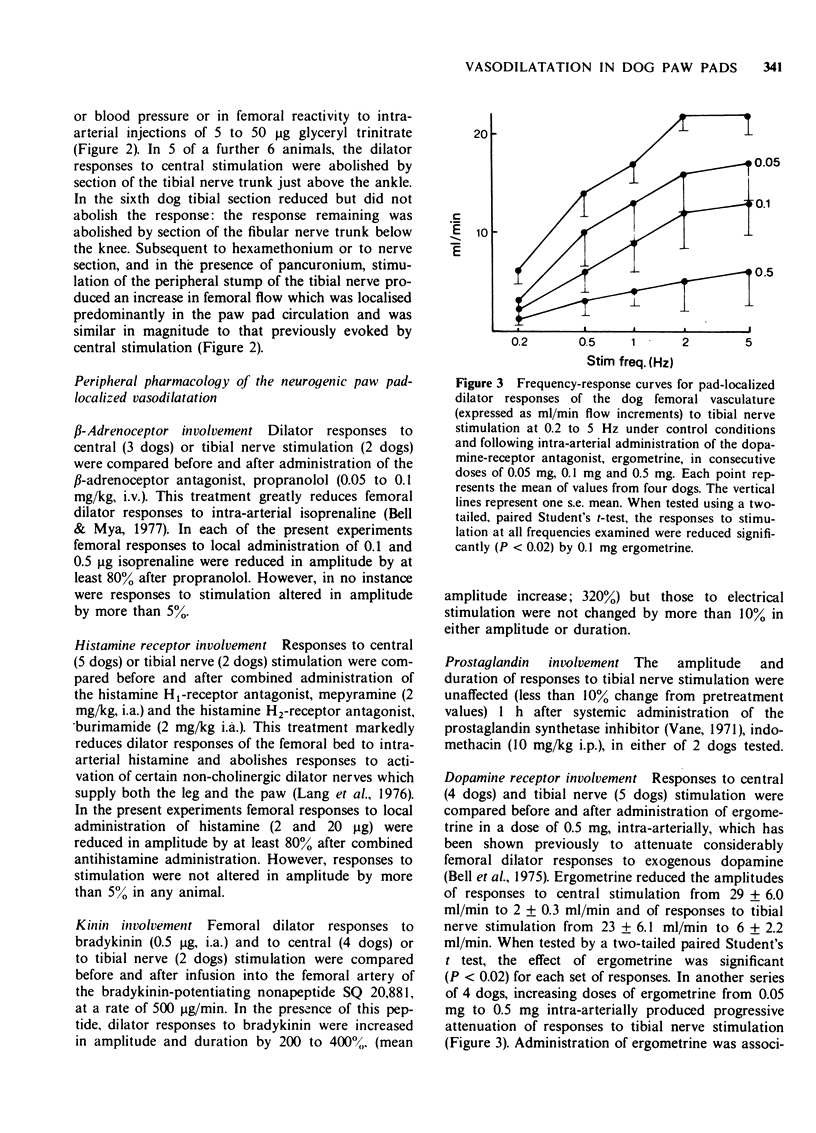
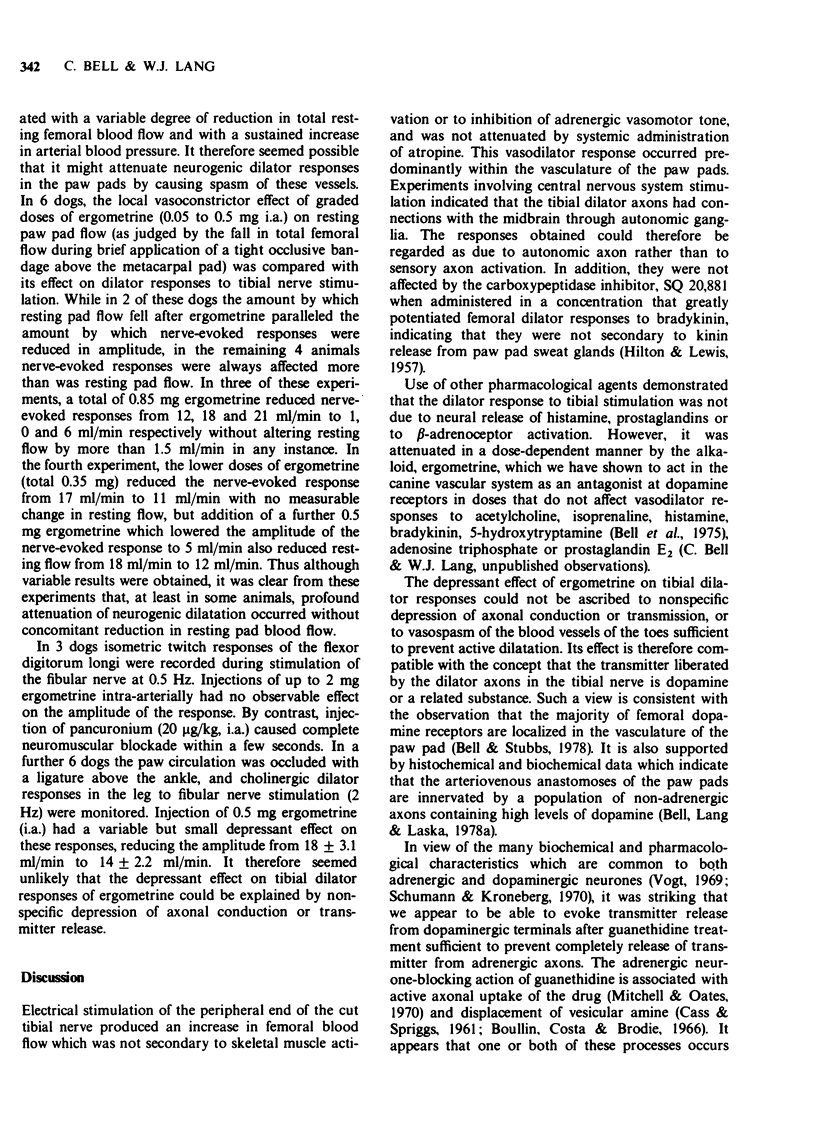
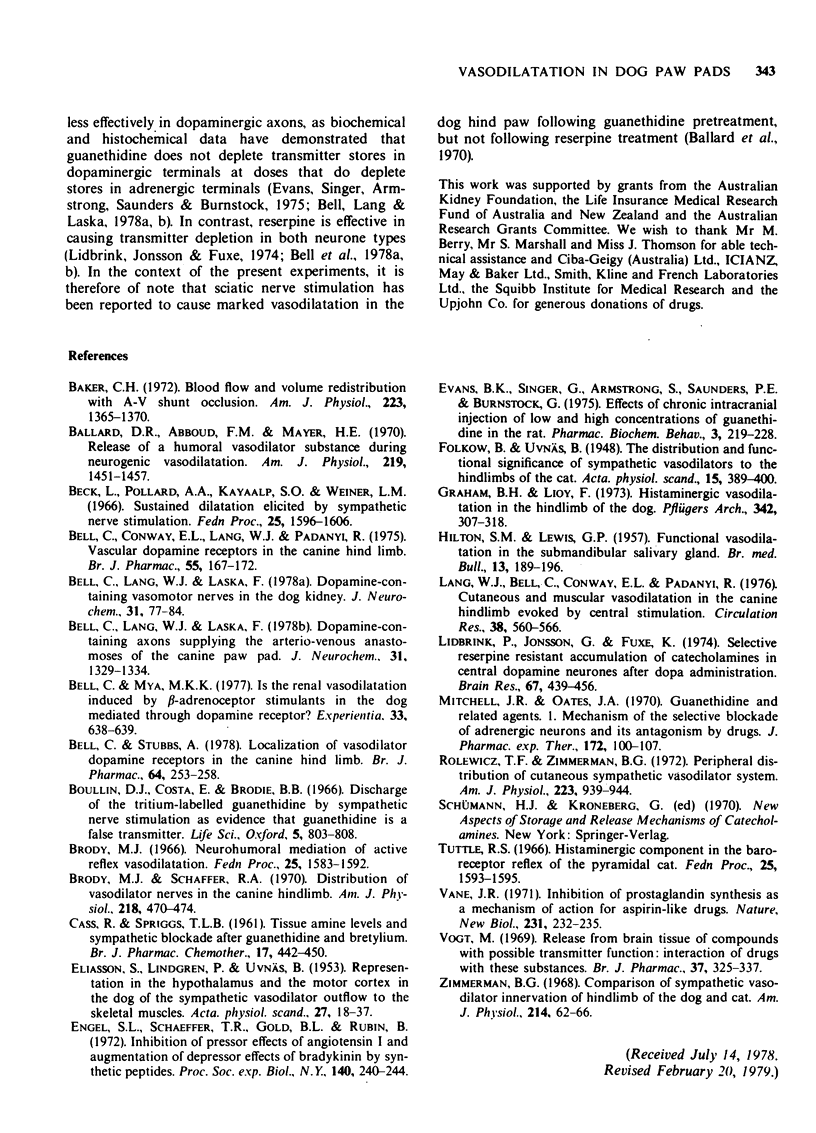
Selected References
These references are in PubMed. This may not be the complete list of references from this article.
- Baker C. H. Blood flow and volume redistribution with A-V shunt occlusion. Am J Physiol. 1972 Dec;223(6):1365–1370. doi: 10.1152/ajplegacy.1972.223.6.1365. [DOI] [PubMed] [Google Scholar]
- Ballard D. R., Abboud F. M., Mayer H. E. Release of a humoral vasodilator substance during neurogenic vasodilatation. Am J Physiol. 1970 Nov;219(5):1451–1457. doi: 10.1152/ajplegacy.1970.219.5.1451. [DOI] [PubMed] [Google Scholar]
- Beck L., Pollard A. A., Kayaalp S. O., Weiner L. M. Sustained dilatation elicited by sympathetic nerve stimulation. Fed Proc. 1966 Nov-Dec;25(6):1596–1606. [PubMed] [Google Scholar]
- Bell C., Conway E. L., Lang W. J., Padanyi R. Vascular dopamine receptors in the canine hindlimb. Br J Pharmacol. 1975 Oct;55(2):167–172. doi: 10.1111/j.1476-5381.1975.tb07625.x. [DOI] [PMC free article] [PubMed] [Google Scholar]
- Bell C., Lang W. J., Laska F. Dopamine-containing axons supplying the arterio-venous anastomoses of the canine paw pad. J Neurochem. 1978 Nov;31(5):1329–1333. doi: 10.1111/j.1471-4159.1978.tb06259.x. [DOI] [PubMed] [Google Scholar]
- Bell C., Lang W. J., Laska F. Dopamine-containing vasomotor nerves in the dog kidney. J Neurochem. 1978 Jul;31(1):77–83. doi: 10.1111/j.1471-4159.1978.tb12435.x. [DOI] [PubMed] [Google Scholar]
- Bell C., Mya M. K. Is the renal vasodilatation induced by beta-adrenoceptor stimulants in the dog mediated through dopamine receptor? Experientia. 1977 May 15;33(5):638–639. doi: 10.1007/BF01946546. [DOI] [PubMed] [Google Scholar]
- Bell C., Stubbs A. Localization of vasodilator dopamine receptors in the canine hindlimb. Br J Pharmacol. 1978 Oct;64(2):253–257. doi: 10.1111/j.1476-5381.1978.tb17297.x. [DOI] [PMC free article] [PubMed] [Google Scholar]
- Brody M. J. Neurohumoral mediation of active reflex vasodilatation. Fed Proc. 1966 Nov-Dec;25(6):1583–1592. [PubMed] [Google Scholar]
- Brody M. J., Shaffer R. A. Distribution of vasodilator nerves in the canine hindlimb. Am J Physiol. 1970 Feb;218(2):470–474. doi: 10.1152/ajplegacy.1970.218.2.470. [DOI] [PubMed] [Google Scholar]
- CASS R., SPRIGGS T. L. Tissue amine levels and sympathetic blockade after guanethidine and bretylium. Br J Pharmacol Chemother. 1961 Dec;17:442–450. doi: 10.1111/j.1476-5381.1961.tb01131.x. [DOI] [PMC free article] [PubMed] [Google Scholar]
- ELIASSON S., LINDGREN P., UVNAS B. Representation in the hypothalamus and the motor cortex in the dog of the sympathetic vasodilator outflow to the skeletal muscles. Acta Physiol Scand. 1952;27(1):18–37. doi: 10.1111/j.1748-1716.1953.tb00921.x. [DOI] [PubMed] [Google Scholar]
- Engel S. L., Schaeffer T. R., Gold B. I., Rubin B. Inhibition of pressor effects of angiotensin I and augmentation of depressor effects of bradykinin by synthetic peptides. Proc Soc Exp Biol Med. 1972 May;140(1):240–244. doi: 10.3181/00379727-140-36433. [DOI] [PubMed] [Google Scholar]
- Evans B. K., Singer G., Armstrong S., Saunders P. E., Burnstock G. Effects of chronic intracranial injection of low and high concentrations of guanethidine in the rat. Pharmacol Biochem Behav. 1975 Mar-Apr;3(2):219–228. doi: 10.1016/0091-3057(75)90151-3. [DOI] [PubMed] [Google Scholar]
- Graham B. H., Lioy F. Histaminergic vasodilatation in the hindlimb of the dog. Pflugers Arch. 1973 Sep 16;342(4):307–318. doi: 10.1007/BF00586102. [DOI] [PubMed] [Google Scholar]
- HILTON S. M., LEWIS G. P. Functional vasodilatation in the submandibular salivary gland. Br Med Bull. 1957 Sep;13(3):189–196. doi: 10.1093/oxfordjournals.bmb.a069612. [DOI] [PubMed] [Google Scholar]
- Lang W. J., Bell C., Conway E. L., Padanyi R. Cutaneous and muscular rasodilation in the canine hindlimb evoked by central stimulation. Circ Res. 1976 Jun;38(6):560–566. doi: 10.1161/01.res.38.6.560. [DOI] [PubMed] [Google Scholar]
- Lidbrink P., Jonsson G., Fuxe K. Selective reserpine-resistant accumulation of catecholamines in central dopamine neurones after DOPA administration. Brain Res. 1974 Mar 8;67(3):439–456. doi: 10.1016/0006-8993(74)90493-4. [DOI] [PubMed] [Google Scholar]
- Mitchell J. R., Oates J. A. Guanethidine and related agents. I. Mechanism of the selective blockade of adrenergic neurons and its antagonism by drugs. J Pharmacol Exp Ther. 1970 Mar;172(1):100–107. [PubMed] [Google Scholar]
- Rolewicz T. F., Zimmerman B. G. Peripheral distribution of cutaneous sympathetic vasodilator system. Am J Physiol. 1972 Oct;223(4):939–943. doi: 10.1152/ajplegacy.1972.223.4.939. [DOI] [PubMed] [Google Scholar]
- Tuttle R. S. Histaminergic component in the baroreceptor reflex of the pyramidal cat. Fed Proc. 1966 Nov-Dec;25(6):1593–1595. [PubMed] [Google Scholar]
- Vane J. R. Inhibition of prostaglandin synthesis as a mechanism of action for aspirin-like drugs. Nat New Biol. 1971 Jun 23;231(25):232–235. doi: 10.1038/newbio231232a0. [DOI] [PubMed] [Google Scholar]
- Vogt M. Release from brain tissue of compounds with possible transmitter function: interaction of drugs with these substances. Br J Pharmacol. 1969 Oct;37(2):325–337. doi: 10.1111/j.1476-5381.1969.tb10570.x. [DOI] [PMC free article] [PubMed] [Google Scholar]
- Zimmerman B. G. Comparison of sympathetic vasodilator innervation of hindlimb of the dog and cat. Am J Physiol. 1968 Jan;214(1):62–66. doi: 10.1152/ajplegacy.1968.214.1.62. [DOI] [PubMed] [Google Scholar]


